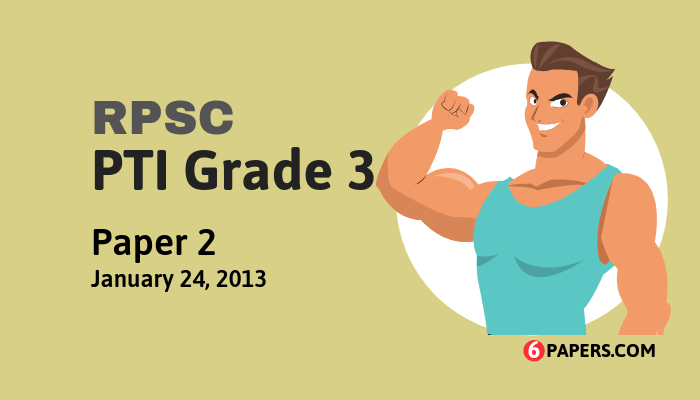RPSC PTI Grade 3 exam paper – 2011 (Paper 2) in English language: RPSC PTI (Physical Training Instructor) Grade 3 exam Paper – 2 with Answer Key available here. This RPSC PTI Grade 3 examination was conducted by the Rajasthan Public Service Commission (RPSC) in Rajasthan state on January 24, 2013.
For the second paper of this examination – click here.
RPSC PTI Grade 3 exam – 2011 (Second Paper)
1. Who has given this definition “Physical Education is the field of Education is that field of education which deals with big muscles and their related responses” ?
(A) C.C. Cowell
(B) J.F. William
(C) J.B. Nash
(D) H.C. Buck
Show Answer
Hide Answer
2. The objective of Physical Education is :
(A) Development of sports
(B) Improvement of fitness
(C) Longevity
(D) Wholesome development personality
Show Answer
Hide Answer
3. Which is the common objective of Education and Physical Education ?
(A) Neuro muscular development
(B) Physical development
(C) Development of sports
(D) Mental development
Show Answer
Hide Answer
4. The need of Physical Education is :
(A) Improve general fitness of people
(B) Understand human relationship
(C) Preserve natural resources
(D) Understanding heredity and environment
Show Answer
Hide Answer
5. The misconception of Physical Education is that :
(A) It deals with physical development
(B) Doing Exercise in Physical Education
(C) It deals with social development
(D) It deals with mental development
Show Answer
Hide Answer
6. Physical Education deals with :
(A) Health Education
(B) Science Education
(C) Adult Education
(D) Education for all
Show Answer
Hide Answer
7. Physical Education is important because :
(A) It helps to think positively
(B) It helps to promote brotherhood
(C) It helps to lead a healthy life
(D) It helps to lead a quality life
Show Answer
Hide Answer
8. Which of the factors is not affecting physical fitness ?
(A) Sound sleep and rest.
(B) Daily exercise
(C) Balance diet
(D) Reading and writing
Show Answer
Hide Answer
9. Sports sociology deals with :
(A) Team cohesion
(B) Function of the body
(C) Mental training
(D) Motivation
Show Answer
Hide Answer
10. Which one of the following does not contribute to the development of Physical Education and wellness ?
(A) Daily regular exercise
(B) Playing games and sports
(C) Reading and writing about Physical Education
(D) Doing Yoga exercise
Show Answer
Hide Answer
11. The importance of wellness is :
(A) It helps to lead a quality life.
(B) It helps to extend co-operation to others.
(C) It helps to satisfy your need,
(D) It helps to inculcate good habits.
Show Answer
Hide Answer
12. Which of the following is our cultural heritage ?
(A) Education
(B) Sports
(C) Love and affection
(D) Respect of elders
Show Answer
Hide Answer
13. Kinesiology is a study of :
(A) Human motion
(B) Motor movements
(C) Physical fitness
(D) Anthropology
Show Answer
Hide Answer
14. Third law of motion is also called :
(A) Law of inertia
(B) Law of acceleration
(C) Law of action and reaction
(D) Law of speed
Show Answer
Hide Answer
15. Who was the exponents of law of motion ?
(A) Aristotle
(B) Newton
(C) J.B. Nash
(D) Galileo
Show Answer
Hide Answer
16. Second class lever has :
(A) Fulcrum is in between force and resistance
(B) Force is in between fulcrum and resistance
(C) Resistance is in between fulcrum and force
(D) It is without fulcrum
Show Answer
Hide Answer
17. The majority of lever in human body are.
(A) First Class
(B) Second Class
(C) Third Class
(D) Fourth Class
Show Answer
Hide Answer
18. First class lever is capable of magnifying :
(A) Only force
(B) Only speed
(C) Only strength
(D) Force and speed both
Show Answer
Hide Answer
19. Equilibrium depends :
(A) wider base of the object
(B) more height of the object
(C) longer weight of the object
(D) narrow base and light weight
Show Answer
Hide Answer
20. Kyphosis deformity is also called :
(A) Hollow back
(B) Round back
(C) Lateral back
(D) Back curve
Show Answer
Hide Answer


Leave a Reply